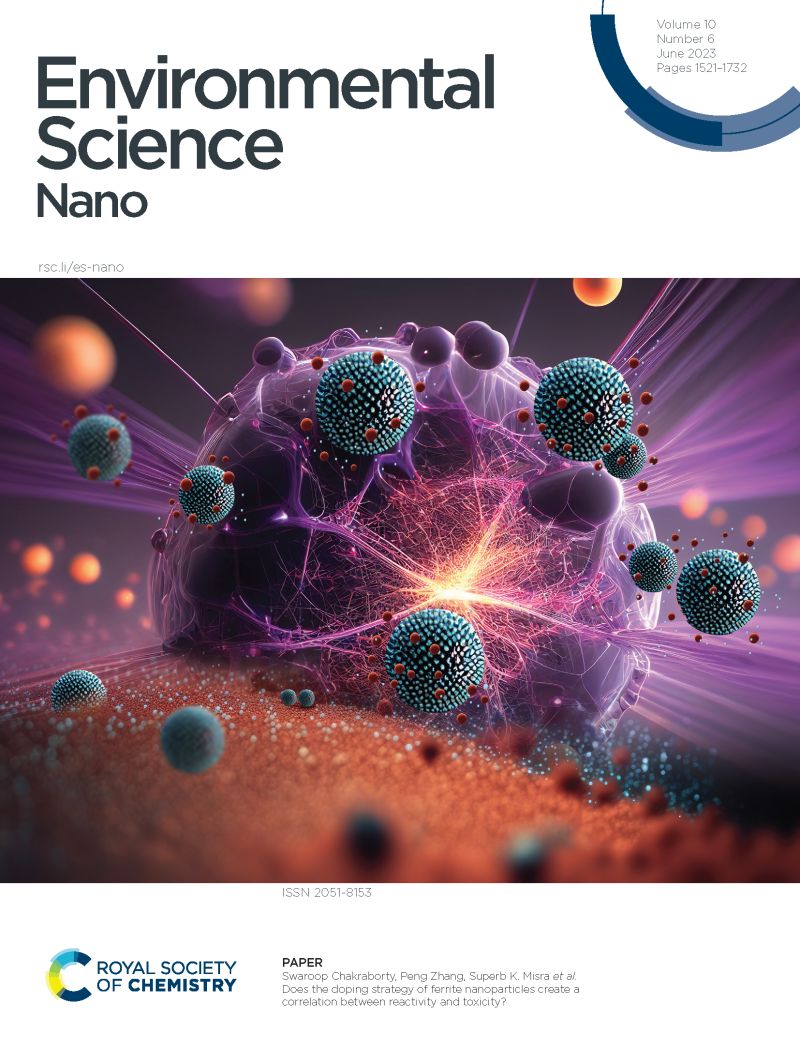Critical Role of Coexistence Order and Interfacial Forces in the Aggregation of Polystyrene Nanoplastics Induced by Nano-SiO2 and Metal Cations
IF 5.8
2区 环境科学与生态学
Q1 CHEMISTRY, MULTIDISCIPLINARY
引用次数: 0
Abstract
This study investigated the aggregation of polystyrene (PS) NPs by kinetics experiments, considering single, simultaneous, and sequential addition of silica (SiO2) nanoparticles and metal cations. Results demonstrated that ion concentration and strength played a crucial role in determining PS stability across all systems. Surface interaction forces, particularly van der Waals forces, were fundamental mechanisms for PS aggregation. In simultaneous addition system, SiO2 improved PS stability. The higher the concentration of SiO2, the more significant its stabilizing effect on PS, as SiO2 competed with PS for metal cations. DLVO calculations and zeta potential analyses suggested that electric double layer repulsion was primary factor behind PS stabilization by SiO2. Additionally, other non-DLVO forces, such as hydrogen bonding and π-π interactions, might also affect the stabilization. SiO2 was found to promote PS aggregation in the sequential addition system, contrasting with its stabilizing effect in the simultaneous addition system. The increase in aggregate size was primarily attributed to the bridging effects, though the enhanced electrostatic repulsion prevented a substantial rise in aggregate size. This study highlights how the presence of non-plastic particles influences the environmental behavior of NPs and deepens our understanding of the interactions between PS NPs and SiO2 in complex and realistic aqueous environments.共存顺序和界面力在纳米sio2和金属阳离子诱导聚苯乙烯纳米塑料聚集中的关键作用
本研究通过动力学实验研究了聚苯乙烯(PS)NPs 的聚合,考虑了单一、同时和顺序添加二氧化硅(SiO2)纳米粒子和金属阳离子的情况。结果表明,在所有体系中,离子浓度和强度对决定 PS 的稳定性起着至关重要的作用。表面相互作用力,尤其是范德华力,是 PS 聚集的基本机制。在同时添加体系中,二氧化硅提高了 PS 的稳定性。二氧化硅的浓度越高,对 PS 的稳定作用就越明显,因为二氧化硅与 PS 竞争金属阳离子。DLVO 计算和 zeta 电位分析表明,电双层排斥是二氧化硅稳定 PS 的主要因素。此外,其他非 DLVO 作用力,如氢键和 π-π 相互作用,也可能会影响稳定效果。在连续添加体系中,SiO2 会促进 PS 的聚集,而在同时添加体系中,SiO2 的稳定作用则相反。聚合体尺寸的增加主要归因于架桥效应,尽管增强的静电斥力阻止了聚合体尺寸的大幅增加。这项研究强调了非塑料粒子的存在如何影响 NPs 的环境行为,并加深了我们对 PS NPs 和 SiO2 在复杂而真实的水环境中的相互作用的理解。
本文章由计算机程序翻译,如有差异,请以英文原文为准。
求助全文
约1分钟内获得全文
求助全文
来源期刊

Environmental Science: Nano
CHEMISTRY, MULTIDISCIPLINARY-ENVIRONMENTAL SCIENCES
CiteScore
12.20
自引率
5.50%
发文量
290
审稿时长
2.1 months
期刊介绍:
Environmental Science: Nano serves as a comprehensive and high-impact peer-reviewed source of information on the design and demonstration of engineered nanomaterials for environment-based applications. It also covers the interactions between engineered, natural, and incidental nanomaterials with biological and environmental systems. This scope includes, but is not limited to, the following topic areas:
Novel nanomaterial-based applications for water, air, soil, food, and energy sustainability
Nanomaterial interactions with biological systems and nanotoxicology
Environmental fate, reactivity, and transformations of nanoscale materials
Nanoscale processes in the environment
Sustainable nanotechnology including rational nanomaterial design, life cycle assessment, risk/benefit analysis
 求助内容:
求助内容: 应助结果提醒方式:
应助结果提醒方式:


